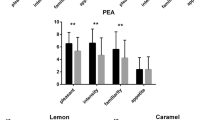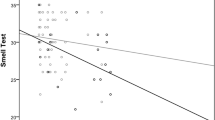Abstract
Objective
Young patients admitted to the hospital due to anorexia nervosa report reduced pleasure and impaired perception of smell while eating. So far, two studies on odour identification ability in eating disorders did not suggest any significant deficits. Therefore a new and more detailed method of olfactory testing may be needed, in order to determine the subjective impairment of olfaction.
Method
By using all three subtests of the recently developed smell test called “Sniffin’ Sticks”, the olfactory deficits were assessed in more detail and the results of female anorectic patients (n = 17) were compared with those of healthy females (n = 15).
Results
By examining the anorectic patients no deficits in the subtest odour identification were found. On the contrary, in the subtests odour discrimination and odour threshold deficits of the anorectic patients were detected.
Conclusion
Reduced olfactory perception might be considered as a common deficit in anorexia nervosa with possible influences and consequences for therapy.
Similar content being viewed by others
References
Drewnowski A (1989) Taste responsiveness in eating disorders. Ann N Y Acad Sci 575:399–408
Drewnowski A, et al. (1987) Taste and eating disorders. Am J Clin Nutrition 46(3):442–450
Sunday SR, Halmi KA (1990) Taste perceptions and hedonics in eating disorders. Physiol Behav 48(5):587–594
Simon Y, et al. (1993) Taste responsiveness in anorexia nervosa. Br J Psychiatry 162:244–246
Henkin RI, Smith FR (1971) Hyposmia in acute viral hepatitis. Lancet 1(7704):823–826
Crawford DZ, Souder E (1995) Smell disorders=danger. Rn 58(11):40–43
Toller SV (1999) Assessing the impact of anosmia: review of a questionnaire’s findings. Chem Senses 24(6):705–712
van Dam FS,et al.(1999) Deterioration of olfaction and gustation as a consequence of total laryngectomy. Laryngoscope 109(7 Pt 1):1150–1155
Temmel AF, et al. (2002) Characteristics of olfactory disorders in relation to major causes of olfactory loss. Arch Otolaryngol Head Neck Surg 128(6):635–641
Miwa T, et al. (2001) Impact of olfactory impairment on quality of life and disability. Arch Otolaryngol – Head & Neck Surgery 127(5):497–503
Schechter PJ, Henkin RI (1974) Abnormalities of taste and smell after head trauma. Journal of Neurology, Neurosurgery, and Psychiatry 37(7):802–810
Doty RL, Shaman P, Dann M (1984) Development of the University of Pennsylvania Smell Identification Test: a standardized microencapsulated test of olfactory function. Physiology & Behavior 32(3):489–502
Kopala LC, et al. (1995) Olfactory identification ability in anorexia nervosa. J Psychiatry Neurosci 20(4):283–286
Kudo H, et al. (2000) Dietary zinc deficiency decreases glutathione S-transferase expression in the rat olfactory epithelium. J Nutrition 130(1):38–44
Bromley SM (2000) Smell and taste disorders: a primary care approach. Am Fam Physician 61(2):427–436:438
Su JC,Birmingham CL (2002) Zinc supplementation in the treatment of anorexia nervosa. Eat Weight Disord 7(1):20–22
Fedoroff IC, et al. (1995) Olfactory dysfunction in anorexia and bulimia nervosa. Int J Eating Disord 18(1):71–77
Steinhausen HC (2002) The outcome of anorexia nervosa in the 20th century. Am J Psychiatry 159(8):1284–1293
Robb AS, et al. (2002) Supplemental nocturnal nasogastric refeeding for better short-term outcome in hospitalized adolescent girls with anorexia nervosa. Am J Psychiatry 159(8):1347–1353
Fisher M, et al. (1995) Eating disorders in adolescents: a background paper. J Adolesc Health 16(6):420–437
Peterson CB, Mitchell JE (1999) Psychosocial and pharmacological treatment of eating disorders: a review of research findings. J Clin Psychol 55(6):685–697
Hummel T, et al. (1997) ‘Sniffin’ sticks’: olfactory performance assessed by the combined testing of odor identification, odor discrimination and olfactory threshold. Chem Senses 22(1):39–52
Doty RL, et al. (1995) A study of the test-retest reliability of ten olfactory tests. Chem Senses 20(6):645–656
Kobal G, et al. (1996) “Sniffin’ sticks”: screening of olfactory performance. Rhinology 34(4):222–226
Wolfensberger M, Schnieper I, Welge-Lussen A (2000) Sniffin’- Sticks: a new olfactory test battery. Acta Otolaryngol 120(2):303–306
Kobal G, Barz S, Hummel T (1992) A combined psychophysical and electrophysiological olfaction test. Chem Senses 17:850–851
Distel H, et al. (1999) Perception of everyday odors–correlation between intensity, familiarity and strength of hedonic judgement. Chem Senses 24(2):191–199
Hummel T, Knecht M, Kobal G (1996) Peripherally obtained electrophysiological responses to olfactory stimulation in man: electro- olfactograms exhibit a smaller degree of desensitization compared with subjective intensity estimates. Brain Res 717(1–2):160–164
Kobal G, et al. (2000) Multicenter investigation of 1,036 subjects using a standardized method for the assessment of olfactory function combining tests of odor identification, odor discrimination, and olfactory thresholds. Eur Arch Otorhinolaryngol 257(4):205–211
Rolls ET, de Waal AW (1985) Long-term sensory-specific satiety: evidence from an Ethiopian refugee camp. Physiology & Behavior 34(6):1017–1020
Hulshoff Pol HE, et al. (2000) Odor discrimination and task duration in young and older adults. Chem Senses 25(4):461–464
Spence C, et al. (2000) Selective attention to the chemosensory modality. Percept Psychophys 62(6):1265–1271
Serby M, Larson P, Kalkstein D (1990) Olfactory sense in psychoses. Biological Psychiatry 28(9):830
Seidman LJ, et al. (1991) Neuropsychological probes of frontolimbic system dysfunction in schizophrenia. Olfactory identification and Wisconsin Card Sorting performance. Schizophrenia Research 6(1):55–65
Larsson M, Finkel D, Pedersen NL (2000) Odor identification: influences of age, gender, cognition, and personality. Journals of Gerontology Series B: Psychological Sciences and Social Sciences 55(5):304–310
Deems DA, et al. (1991) Smell and taste disorders, a study of 750 patients from the University of Pennsylvania Smell and Taste Center. Arch Otolaryngol – Head & Neck Surgery 117(5):519–528
Schiffman SS (1983) Taste and smell in disease (first of two parts). N Eng J Med 308(21):1275–1279
Schiffman SS (1983) Taste and smell in disease (second of two parts). N Eng J Med 308(22):1337–1343
Schiffman SS, Graham BG (2000) Taste and smell perception affect appetite and immunity in the elderly. Eur J Clin Nutrition 54(Suppl 3):S54–S63
Mathey MF, et al. (2001) Flavor enhancement of food improves dietary intake and nutritional status of elderly nursing home residents. Journals of Gerontology Series A: Biological Sciences and Medical Sciences 56(4):M200–M205
Author information
Authors and Affiliations
Corresponding author
Rights and permissions
About this article
Cite this article
Roessner, V., Bleich, S., Banaschewski, T. et al. Olfactory deficits in anorexia nervosa. Eur Arch Psychiatry Clin Neurosci 255, 6–9 (2005). https://doi.org/10.1007/s00406-004-0525-y
Received:
Accepted:
Published:
Issue Date:
DOI: https://doi.org/10.1007/s00406-004-0525-y




